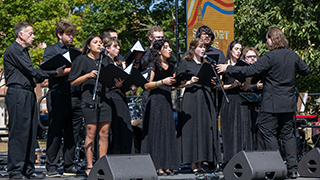The Mystery of the Missing Lock At Monsignor William Noé Field Archives and Special Collections Center
Tuesday, April 14th, 2020

Portrait of Elizabeth Ann Seton | Mary Hayrich | Oil on canvas | 31.5" x 27.5" | 2013.03.0001 | Seton Hall University Permanent Collection.
Mysteries abound in the archival profession — some arising from the vicissitudes of history, and some of our own making. The field of archives has evolved in recent decades from one dominated by aficionados and amateur historians to one highly professionalized and tech-savvy. This has changed the questions we ask about our collections. Instead of "Do I personally find this interesting?" we now ask "Does this object tell a unique story? Is it something a future historian would find key to analyzing its historical moment?" We re-evaluate our collections, hoping to foreground and publicize materials of truly longstanding value.
One of those objects that we were re-evaluating in recent years was a black metal box marked only "Seton Papers." Normally no archivist, even the most sentimental, would retain an empty box. But given the label on this one, we withheld judgement and investigated. Unfortunately we could turn up nothing. It came from a time that few records were kept, and nothing in the collection files shed light on the mystery. Finally, there was a breakthrough. Special Collections Assistant Jacquelyn Deppe, who had been re-organizing our collection of university publications, found a photo of the box in an article from 1976, published in the Catholic Advocate. The article documented the acquisition of the Seton-Jevons papers, our collection of manuscripts from the family of Saint Elizabeth Ann Seton. So far, so good — now we knew where it came from, and could properly integrate it into our collections with the full story of its origin.
However, the photograph sparked new questions as well. It showed then-archives director and institutional namesake Monsignor William Noe Field holding a lock of hair, in a tight coil, that came with the papers — a lock of Elizabeth Ann Seton's hair. Amazing! None of us had ever seen the hair in the collection, though. We worried it might have been lost. If not properly labeled and stored, who would know its true meaning?
Luckily, Archdiocesan Archivist Brianna LoSardo happened to be putting the finishing touches on her project of processing the papers of Monsignor Field. She had finished most of the collection, but was hung up on a few last objects, including a monstrance that had been part of Father Field's office. It had been refashioned into a reliquary, and was said to contain a lock of hair, but she had no idea whose it was. Brianna had been afraid to open it in case she might break it. With the help of Collections Manager Romana Schaeffer, we were able to safely open the monstrance and see the hair. Lo and behold, it looked exactly like the hair in the photo, down to the way it was coiled! We are now 99 percent sure that after the Seton-Jevons papers came in, Father Field housed Mother Seton's hair in this monstrance. University Archivist Alan Delozier, who knew Monsignor Field personally, said he kept it in his office as one of his most prized possessions.
Now we know that this lock of hair comes from the namesake of our University and are able to safely and properly store, recognize, and appreciate the value of this unique object. Although special collections professionals have very different kinds of experience and expertise, when we all come together, making our unique contributions to a shared problem, amazing breakthroughs like this are the result!
Categories: Arts and Culture






